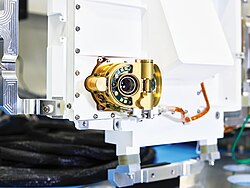

Scanning Habitable Environments with Raman and Luminescence for Organics and Chemicals (SHERLOC) is an ultraviolet Raman spectrometer that uses fine-scale imaging and an ultraviolet (UV) laser to determine fine-scale mineralogy, and detect organic compounds designed for the Perseverance rover as part of the Mars 2020 mission. [1] [2] [3] It was constructed at the Jet Propulsion Laboratory with major subsystems being delivered from Malin Space Science Systems and Los Alamos National Laboratory.
Contents
SHERLOC has a calibration target with possible Mars suit materials, and it will measure how they change over time in the Martian surface environment. [4]







